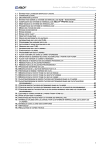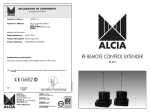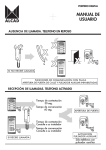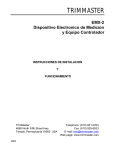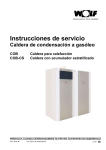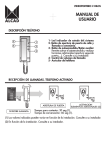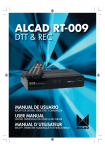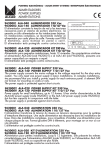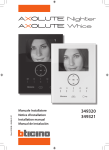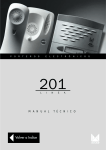Download KITS PORTERO DIGITAL - DIGITAL DOOR ENTRY
Transcript
PORTERO DIGITAL - DIGITAL DOOR ENTRY SYSTEMS - PORTIER NUMÉRIQUE KITS TED-001 GRF-200 Tabla de secciones Section table Tableau de sections D1 D2 KIT 2 VIVIENDAS 2 DWELLINGS KIT KIT 2 LOGEMENTS D1 D2 KIT 1 VIVIENDA 1 DWELLING KIT KIT 1 LOGEMENT ALC-041 Tabla de secciones Section table Tableau de sections TED-001 TED-001 AWG Dist. AWG Dist. A 1 mm2 17 100m A 1 mm2 17 100m B 1 mm2 17 25m B 1 mm2 17 25m D1 D2 ~ ALC-041 ~ –+ –+ A 230V ~ ALC-041 ~ –+ –+ B Placa de calle Entrance panel Plaque de rue –+ 9 10 12 S C 11 1 –+ 7 D1 D2 D3 8 7 6 5 4 3 2 1 GRF-200 ABR-015 A B Placa de calle Entrance panel Plaque de rue +– BUS 230V BUS TED-001 9 10 12 S C 11 1 7 D1 D2 D3 8 7 6 5 4 3 2 1 GRF-200 APERTURA DE PUERTA EXIT BUTTON OUVRE-PORTE LOCAL +– APERTURA DE PUERTA EXIT BUTTON OUVRE-PORTE LOCAL ABR-015 MANUAL DE INSTALACIÓN ....................2 INSTALLATION DATA SHEET ....................9 FEUILLE D’INSTALLATION ..................16 PORTERO DIGITAL ÍNDICE ELEMENTOS Y DIMENSIONES .................................................................................................................... 2 INSTALACIÓN DE ELEMENTOS ADICIONALES ......................................................................................... 3 CONEXIÓN ABREPUERTAS AC ............................................................................................................. 3 CONEXIÓN ABREPUERTAS INVERSO ................................................................................................... 3 APERTURA DE PUERTA AUTOMÁTICA ................................................................................................... 3 TELÉFONOS ADICIONALES .................................................................................................................. 3 2 PLACAS DE CALLE EN VIVIENDA UNIFAMILIAR (2 x KIT 1 VIVIENDA) ................................................. 4 INSTRUCCIONES DE PROGRAMACIÓN DE LOS TELÉFONOS ................................................................ 4 INSTRUCCIONES DE INSTALACIÓN ........................................................................................................... 5 ALIMENTADOR .................................................................................................................................... 5 TELÉFONO .......................................................................................................................................... 5 CAJA DE EMPOTRAR ........................................................................................................................... 6 PLACA DE CALLE.................................................................................................................................. 6 AJUSTE DEL VOLUMEN DE AUDIO ........................................................................................... 6 CARACTERÍSTICAS TÉCNICAS ..................................................................................................................... 7 SOLUCIÓN DE PROBLEMAS ....................................................................................................................... 8 ELEMENTOS Y DIMENSIONES 84 mm 12 mm Caja de empotrar de 1, 2 alturas. 31 mm B1 B2 B2 B3 3 mm Alimentador Abrepuertas * Incluido según modelo PLACA DE CALLE - MÓDULOS INTERIORES 9610018 GRF-200 Grupo fónico ESP-2 Teléfono 160 mm * 100 mm 230 V 60 mm 30 mm 106 mm 90 mm 224 mm 131 mm ARRIBA UP HAUT Placa de calle 50.6 mm 45 mm 114 mm 147 mm 128 mm PORTERO DIGITAL INSTALACIÓN DE ELEMENTOS ADICIONALES CONEXIÓN ABREPUERTAS INVERSO CONEXIÓN ABREPUERTAS AC * 230V ALC-041 ~ ~ 230V ~ ALC-041 ~ 230V –+ –+ ~ ALA-040 ~ –+ –+ –+ 9 10 12 7 D1 D2 D3 9 10 12 S C 11 1 7 D1 D2 D3 8 7 6 5 4 3 2 1 GRF-200 8 7 6 5 4 3 2 1 GRF-200 * ASC-050 * * Ctrl1 Ctrl2 –+ S C 11 1 –+ 15 V . 500mA * No incluido en el Kit ABR-001 * No incluido en el Kit APERTURA DE PUERTA AUTOMÁTICA 230V ALC-041 ~ ~ –+ –+ –+ 9 10 12 S C 11 1 7 D1 D2 D3 8 7 6 5 4 3 2 1 GRF-200 Puerta automática TELÉFONOS ADICIONALES TED-001 BUS Placa de calle TED-001 TED-001 D1 D2 * D1 D2 * D1 D2 D1 D2 * TED-001 AMPLIACIÓN CON TELÉFONOS: Es posible instalar un total de hasta 4 teléfonos que respondan a una misma llamada de la placa de calle. Una vez conectados, prográmelos tal y como se explica en la página 4 de este manual. * No incluido en el Kit ESP-3 PORTERO DIGITAL 230V Deberá volver a programar uno de los teléfonos, consulte página XX TED-001 230V –+ –+ ~ ALC-041 ~ Placa de calle principal TED-001 D1 D2 Sólo debe haber una placa principal por instalación (Puente J1 colocado) D1 D2 2 PLACAS DE CALLE EN VIVIENDA UNIFAMILIAR (2 x KIT 1 VIVIENDA) ALC-041 Placa de calle Secundaria J1 –+ 9 10 12 S C 11 1 ~ ~ –+ –+ J1 –+ 7 D1 D2 D3 8 7 6 5 4 3 2 1 GRF-200 9 10 12 S C 11 1 7 D1 D2 D3 8 7 6 5 4 3 2 1 GRF-200 +– +– ABR-015 ABR-015 AMPLIACIÓN CON PLACAS DE CALLE: Es posible instalar un máximo de 10 placas de calle. INSTRUCCIONES DE PROGRAMACIÓN DE LOS TELÉFONOS 1. Desplace el interruptor PROG a la posición OFF; Vuelva a poner el interruptor en la posición ON. 2. Pulse el botón de abrepuertas. Se activará el audio entre el teléfono y la placa principal. 3. Situado en la placa de calle principal, realice la llamada a la vivienda donde está situado el teléfono a programar. La placa emitirá un sonido de confirmación, el teléfono ha sido programado. 1 2 3 PROG 1 2 OFF PROG ON PROG Nota: Una vez programado el teléfono, asegúrese de que el interruptor PROG queda en posición ON. Nota: Tiempo máximo de 1 minuto entre los pasos 1, 2 y 3. Pasado el tiempo máximo deberá iniciar la programación desde el paso 1. ESP-4 PORTERO DIGITAL INSTRUCCIONES DE INSTALACIÓN ALIMENTADOR Consulte las instrucciones de seguridad al final del presente documento. Proteja el alimentador, cumpliendo con la normativa vigente en materia de instalaciones eléctricas (magneto térmicos, diferenciales...). 1A Montaje a pared 1B Montaje en carril DIN 2 3 TELÉFONO 1 2 3 2 1 4 5 ESP-5 PORTERO DIGITAL CAJA DE EMPOTRAR Rompa el tabique de las aberturas que requiera para pasar los cables, y coloque la caja de empotrar de modo que la parte superior quede a una altura de 1,7 m. 1 2 1,7 m PLACA DE CALLE Coloque Las tarjetas identificadoras de los pulsadores de la placa de calle, introduzca las anillas de la placa sobre las bisagras de la caja de empotrar y realice las conexiones eléctricas. 1 2 3 TARJETAS IDENTIFICADORAS DE LOS PULSADORES: Puede utilizar las tarjetas preimpresas que se suministran o utilizar la plantilla que encontrará en la página Web de Alcad: www.alcad.net, dentro del apartado Soporte técnico. Realice una llamada de prueba y ajuste el volumen de audio de la placa de calle y de los teléfonos. 4 5 Volumen En placa En teléfonos ESP-6 6 Regulador acoplamiento acústico PORTERO DIGITAL Cierre la placa, presionándola contra la caja de empotrar y fíjela a la misma mediante los tornillos de sujeción. 7 8 9 CARACTERÍSTICAS TÉCNICAS GRUPO FÓNICO GRF-200 GRF-200 Tensión: ALIMENTACIÓN: 15 V Corriente: TEMPERATURA DE FUNCIONAMIENTO: 650 mA (máx.) -10.. +55 OC TENSIONES USUALES SEGÚN EL ESTADO DEL EQUIPO BORNAS REPOSO +,– TRABAJO 15 V ±10% D1, D2 10 - 12 V D3, D2 10 - 12 V 22, 11 SC1, 11 15 V 4,5 V 7, 11 12, 11 0V ±10% 0V 5V ±10% ±10% 0V 15 V ±10% , 12 TELÉFONO DIGITAL TED-001 TED-001 Tensión: ALIMENTACIÓN: 10-12 V Corriente: TEMPERATURA DE FUNCIONAMIENTO: 200 mA (máx.) +5.. +55 OC TENSIONES USUALES SEGÚN EL ESTADO DEL EQUIPO BORNAS D1, D2 REPOSO TRABAJO 10 - 12 V ESP-7 PORTERO DIGITAL ALIMENTADOR ALC-041 ALC-041 ALIMENTACIÓN DE RED: Tensión: 230 V~ ±10% 50/60Hz Potencia: 25 VA Tensión: SALIDA 1: 15 V Corriente: Tensión: SALIDA 2: 15 V Corriente: TEMPERATURA DE FUNCIONAMIENTO: ±10% 0.8 A (máx.) ±10% 0.8 A (máx.) -10.. +55 OC SOLUCIÓN DE PROBLEMAS No funciona nada Verifique la tensión de red en el alimentador. Verifique que la tensión entre + y – del alimentador sea 17 ± 10% Vdc. Compruebe si existe algún cortocircuito y soluciónelo. Desconecte el alimentador de la red durante 1 minuto y vuelva a conectarlo. Si la avería continúa, desconecte todas las bornas + y – del alimentador, y verifique que la tensión entre + y – sea 21 ± 10% Vdc. Si no es correcta el alimentador puede estar averiado. No se ilumina el piloto del pulsador de iluminación Verifique que la tensión entre + y – del grupo fónico sea 17 ± 10% Vdc. Si la tensión es correcta, el grupo fónico puede estar averiado. No se iluminan los tarjeteros Verifique que la tensión entre + y – del alimentador sea 17 ± 10% Vdc. Verifique que la tensión entre 9 y 10 del grupo fónico, con el pulsador de iluminación accionado, sea 17 ± 10% Vdc. Compruebe que la lámpara no esté fundida. La placa de calle no emite ningún sonido al llamar Revise las conexiones entre el grupo fónico y los pulsadores. Si no detecta el fallo, el grupo fónico puede estar averiado. Si la placa emite tonos intermitentes al llamar La llamada no ha sonado en el teléfono: Compruebe que el auricular está colgado. Compruebe que el interruptor de programación del teléfono está en la posición ON (a la izquierda). Revise la conexión D1, D2 del grupo fónico hacia los teléfonos. Si es el caso, revise las conexiones D3, D2 de los equipos de la instalación. Si no detecta el fallo, el teléfono o el grupo fónico pueden estar averiados. No se oye ningún teléfono desde la placa de calle Compruebe el ajuste del regulador de volumen de audio en placa. Si no detecta el fallo, el grupo fónico puede estar averiado. No se oye un teléfono desde la placa de calle Revise las conexiones del cable entre el auricular y la base del teléfono. Compruebe el pulsador de colgado de la base del teléfono. Si no detecta el fallo, el teléfono puede estar averiado. El sonido se acopla. Ajuste el regulador de desacoplo del grupo fónico (vea página 6). Si el acoplo persiste baje el volumen de sonido mediante los reguladores de volumen del grupo fónico. Suena la llamada en los teléfonos pero en la placa de calle no se oye la confirmación de llamada No funciona el abrepuertas Si el led rojo de la placa parpadea continuamente En instalaciones de múltiple acceso, llamando en una de las placas de calle no se inhabilitan el resto de placas del sistema. Compruebe el ajuste del regulador de volumen de audio en placa. Si no detecta el fallo, el grupo fónico puede estar averiado. Verifique que ha definido una sola placa de calle como principal. Compruebe si existe algún cortocircuito en las conexiones D1, D2 del grupo fónico hacia teléfonos. Si es el caso, revise las conexiones D3, D2 de los equipos de la instalación. Si no detecta el fallo, el grupo fónico puede estar averiado. ESP-8 Con el puente entre las bornas 10 y , verifique que la tensión entre las bornas 12 y 11 del grupo fónico, sea 17 ± 10% Vdc, realizando un puente entre las bornas 22 y 11. Si no detecta el fallo, el abrepuertas puede estar averiado. Compruebe las conexiones D3, D2 entre las diferentes placas del sistema. Si no detecta el fallo, el grupo fónico puede estar averiado. DIGITAL DOOR ENTRY SYSTEMS INDEX ELEMENTS AND DIMENSIONS ................................................................................................................... 9 INSTALLATION OF ADDITIONAL ELEMENTS ........................................................................................... 10 HOW TO CONNECT AC ELECTRIC LOCK ........................................................................................... 10 HOW TO CONNECT INVERSE ELECTRIC LOCK ................................................................................... 10 AUTOMATIC DOOR OPENING ........................................................................................................... 10 ADDITIONAL TELEPHONES................................................................................................................. 10 INSTALLATION IN DETACHED HOUSES WITH 2 POINTS OF ENTRY (2 X 1 DWELLING KIT) ................... 11 TELEPHONE PROGRAMMING INSTRUCTIONS .................................................................................... 11 INSTALLING INSTRUCTIONS .................................................................................................................... 12 POWER SUPPLY UNIT ......................................................................................................................... 12 TELEPHONE ....................................................................................................................................... 12 FLUSH MOUNTED BOX ...................................................................................................................... 13 ENTRANCE PANEL ............................................................................................................................. 13 ADJUSTING THE VOLUME ..................................................................................................... 13 TECHNICAL CHARACTERISTICS................................................................................................................. 14 TROUBLE SHOOTING ................................................................................................................................ 15 ELEMENTS AND DIMENSIONS 84 mm 114 mm 131 mm ARRIBA UP HAUT Flush-mounted box of 1, 2 storeys. * 31 mm B1 B2 B2 B3 3 mm Power supply Telephone 160 mm 230 V 60 mm 100 mm 90 mm 106 mm 30 mm Entrance panel 50.6 mm 45 mm 224 mm 12 mm 147 mm 128 mm Lock release * On certain models only ENTRANCE PANEL - INSIDE MODULES 9610018 GRF-200 Audio unit ENG-9 DIGITAL DOOR ENTRY SYSTEMS INSTALLATION OF ADDITIONAL ELEMENTS HOW TO CONNECT INVERSE ELECTRIC LOCK HOW TO CONNECT AC ELECTRIC LOCK * 230V ALC-041 ~ ~ 230V ~ ALC-041 ~ 230V –+ –+ ~ ALA-040 ~ –+ –+ –+ 9 10 12 7 D1 D2 D3 9 10 12 S C 11 1 7 D1 D2 D3 8 7 6 5 4 3 2 1 GRF-200 8 7 6 5 4 3 2 1 GRF-200 * ASC-050 * * Ctrl1 Ctrl2 –+ S C 11 1 –+ 15 V . 500mA * Not included in the Kit ABR-001 * Not included in the Kit AUTOMATIC GATE OPENING 230V ALC-041 ~ ~ –+ –+ –+ 9 10 12 S C 11 1 7 D1 D2 D3 8 7 6 5 4 3 2 1 GRF-200 Automatic Gate ADDITIONAL TELEPHONES TED-001 BUS Entrance panel ENG-10 TED-001 TED-001 D1 D2 * D1 D2 * D1 D2 D1 D2 * TED-001 EXTENSION WITH TELEPHONES: It is possible to install up to 4 telephones which respond to the same call from the entrance panel. When the telephones are connected, program them following the installation instructions in page 11. * Not included in the Kit DIGITAL DOOR ENTRY SYSTEMS 230V You will have to re-program one of the telephones, see page 14 TED-001 230V –+ –+ ~ ALC-041 ~ Main entrance panel TED-001 D1 D2 An installation must have only one main entrance panel (panel with the jumper J1 installed) D1 D2 INSTALLATION IN DETACHED HOUSES WITH 2 POINTS OF ENTRY (2 x 1 DWELLING KIT) ALC-041 ~ ~ –+ –+ Secondary entrance Panel J1 J1 –+ 9 10 12 S C 11 1 –+ 7 D1 D2 D3 8 7 6 5 4 3 2 1 GRF-200 9 10 12 S C 11 1 7 D1 D2 D3 8 7 6 5 4 3 2 1 GRF-200 +– +– ABR-015 ABR-015 EXTENSION WITH ENTRANCE PANELS: It is possible to install up to 10 entrance panels. TELEPHONE PROGRAMMING INSTRUCTIONS 1. Turn the PROG switch to the OFF position; Turn the switch back to the ON position. 2. Push the lock release button. The audio will be activated between the telephone and the main panel. 3. From the main entrance panel, make the call to the apartment where the telephone to be programmed is installed. The panel emits a confirmation tone, the telephone has been programmed. 1 2 3 PROG 1 2 OFF PROG ON PROG Note: Once the telephone has been programmed, leave the PROG switch to the ON position. Note: Maximum time limit of 1 minute between steps 1, 2 and 3. If the time limit is exceeded the process must be repeated from step 1. ENG-11 DIGITAL DOOR ENTRY SYSTEMS INSTALLING INSTRUCTIONS POWER SUPPLY UNIT See the safety instructions at the end of this booklet. Protect the power supply unit by complying with existing regulations governing electrical installations (avoid high-temperature locations and strong magnetic fields, ensure correct fusing, etc.). 1A Mounting on a wall 1B Mounting on a DIN rail 2 3 TELEPHONE 1 2 3 2 1 4 ENG-12 5 DIGITAL DOOR ENTRY SYSTEMS FLUSH MOUNTED BOX Break off the perforated holes that you need to pass the cables through, and place the flush-mounted box in position so that the top is 1.7 m high. 1 2 1,7 m ENTRANCE PANEL Insert the pushbutton identification cards; place the rings of the entrance panel over the extracted fixing pins of the flush mounted box and make the electrical connections. 1 2 3 PUSHBUTTON IDENTIFICATION CARDS: You can use either the preprinted cards which are provided or print your own using the template available from the Technical Support section of the Alcad web site: www.alcad.net. Make a test call and adjust the entrance panel and telephones volume level. 4 5 Volumen 6 Regulador acoplamiento acústico En placa En teléfonos ENG-13 DIGITAL DOOR ENTRY SYSTEMS Close the panel, press it against the flush-mounted box and fix it to this using the clamping screws. 7 8 9 TECHNICAL CHARACTERISTICS AUDIO UNIT GRF-200 GRF-200 Voltage: POWER SUPPLY: 15 V Current: 650 mA (max.) -10.. +55 OC OPERATING TEMPERATURE: NORMAL VOLTAGES DEPENDING ON THE STATE OF THE EQUIPMENT TERMINALS AT REST +,– 15 V D1, D2 SC1, 11 10 - 12 V 15 V 0V ±10% 0V 4,5 V 7, 11 12, 11 ±10% 10 - 12 V D3, D2 22, 11 WORKING 5V ±10% ±10% 0V 15 V ±10% , 12 DIGITAL TELEPHONE TED-001 TED-001 Voltage: POWER SUPPLY: 10-12 V Current: 200 mA (max.) +5.. +55 OC OPERATING TEMPERATURE: NORMAL VOLTAGES DEPENDING ON THE STATE OF THE EQUIPMENT TERMINALS D1, D2 ENG-14 AT REST WORKING 10 - 12 V DIGITAL DOOR ENTRY SYSTEMS POWER SUPPLY UNIT ALC-041 ALC-041 MAINS SUPPLY: OUTPUT 1: OUTPUT 2: OPERATING TEMPERATURE: Voltage: Power: Voltage: Current: Voltage: Current: 230 V~ ±10% 50/60Hz 25 VA 15 V ±10% 0.8 A (máx.) 15 V ±10% 0.8 A (máx.) -10.. +55 OC TROUBLE SHOOTING Nothing works. Check the mains voltage in the power supply unit. Check that the voltage between + and – of the power supply is 17 ±10% Vdc. Check for the existence of a short circuit and rectify this. Disconnect the power supply for 1 minute and then reconnect it. If ithe breakdown continues, disconnect all the power supply + and – terminals, and check that the voltage between + and – is 21 ±10% Vdc. If you cannot find the fault, there may be something wrong with the power supply. The lighting push-button pilot does not light up. Check that the voltage between + and – in the audio unit is 17 ±10% Vdc. If the voltage is correct, there may be something wrong with the audio unit. The card holders do not light up. Check that the voltage between + and – of the power supply that supplies the audio unit is 17 ±10% Vdc. Check that the voltage between 9 and 10 in the audio unit, with the lighting push-button activated, is 17 ±10% Vdc. Check whether the lamp is burnt out. You cannot hear any sound on the entrance panel when a call is made. Check the connections between the audio unit and the push-buttons. If you cannot find the fault, there may be something wrong with the audio unit. When a call is made, the telephones ring but confirmation of the call cannot be heard on the entrance panel. Check the volume control of the entrance panel audio unit. If you cannot find the fault, there may be something wrong with the audio unit. If the red indicator light flash continuosly. Check that only one entrance panel has been defined as the main one. Check wether there is a shortcircuit in the connections D1, D2 from the audio unit to all the devices. If required, check connections D3, D2 of the equipment in the installation. If you cannot find the fault, there may be something wrong with the audio unit. If intermittent tones can be heard on the entrance panel when a call is made. The call tone cannot be heard on the telephone: Check that the handset is not off the hook. Check that the programming switch of the telephone is in ON position. Check connections D1 and D2 from the audio unit to all the telephones. If required, check connections D3, D2 of the equipment in the installation. If you cannot find the fault, the telephone, the audio unit or some other equipment in the installation may have broken down. No telephone can be heard from the entrance panel. Check the volume control on the panel. If you cannot find the fault, there may be something wrong with the audio unit. One telephone cannot be heard from the entrance panel. Check the cable connections between the receiver and the base of telephone. Check the hanging-up button on the base of the telephone. If you cannot find the fault, there may be something wrong with the telephone. The sound produces feedback. Adjust the feedback control of the audio unit (see page 13). If the feedback persists, lower the volume using the volume controls of the audio unit. The electric lock doesn’t work. With the jumper between terminal 10 and , check that the voltage between 12 and 11 in the audio unit is 17 ±10% Vdc, by making a bridge between terminals 22 and 11. If you cannot find the fault, there may be something wrong with the electric lock. In installations with multiple points of entry, calling on one of the entrance panels does not deactivate the other panels of the system. Check connections D3 and D2 between the different panels of the system. If you cannot find the fault, there may be something wrong with the audio unit. ENG-15 PORTIER NUMÉRIQUE SOMMAIRE ÉLÉMENTS ET MESURES ............................................................................................................................. 16 INSTALLATION D’ÉLÉMENTS ADDITIONNELS ........................................................................................ 17 BRANCHEMENT GÂCHES AC ............................................................................................................ 17 BRANCHEMENT GÂCHE INVERSE ...................................................................................................... 17 OUVERTURE DE PORTE AUTOMATIQUE .............................................................................................. 17 COMBINÉS ADDITIONNELS ............................................................................................................... 17 INSTALLATION INDIVIDUEL AVEC 2 ACCÈS (2 X KIT 1 LOGEMENT) ..................................................... 18 INSTRUCTIONS DE PROGRAMMATION DU COMBINÉ ........................................................................ 18 INSTRUCTIONS D’INSTALLATION ............................................................................................................ 19 ALIMENTATION.................................................................................................................................. 19 COMBINÉ .......................................................................................................................................... 19 BOÎTIER ENCASTRABLE ...................................................................................................................... 20 PLAQUE DE RUE ................................................................................................................................ 20 AJUSTEMENT DU VOLUME .................................................................................................... 20 CARACTÉRISTIQUES TECHNIQUES ........................................................................................................... 21 PROBLÈMES DE FONCTIONNEMENT ....................................................................................................... 22 ÉLÉMENTS ET MESURES 84 mm 114 mm 131 mm ARRIBA UP HAUT Boîtier encastrable de 1, 2 étages. * 31 mm B1 B2 B2 B3 3 mm Alimentation Gâche à émission PLAQUE DE RUE - MODULES INTERIEURS 9610018 GRF-200 Groupe phonique FRA-16 Combiné 160 mm 230 V 60 mm 100 mm 90 mm 106 mm 30 mm Plaque de rue 50.6 mm 45 mm 224 mm 12 mm 147 mm 128 mm * Inclus selon modèle PORTIER NUMÉRIQUE INSTALLATION D’ÉLÉMENTS ADDITIONNELS BRANCHEMENT GÂCHES AC BRANCHEMENT GÂCHE À RUPTURE * 230V ALC-041 ~ ~ 230V ~ ALC-041 ~ 230V –+ –+ ~ ALA-040 ~ –+ –+ –+ 9 10 12 7 D1 D2 D3 9 10 12 S C 11 1 7 D1 D2 D3 8 7 6 5 4 3 2 1 GRF-200 8 7 6 5 4 3 2 1 GRF-200 * ASC-050 * * Ctrl1 Ctrl2 –+ S C 11 1 –+ 15 V . 500mA * Non inclus dans le Kit ABR-001 * Non inclus dans le Kit OUVERTURE DE PORTE AUTOMATIQUE 230V ALC-041 ~ ~ –+ –+ –+ 9 10 12 S C 11 1 7 D1 D2 D3 8 7 6 5 4 3 2 1 GRF-200 Porte automatique COMBINÉS ADDITIONNELS TED-001 TED-001 TED-001 D1 D2 * D1 D2 * D1 D2 D1 D2 * TED-001 EXTENSION AVEC COMBINÉS : Il est possible d’installer jusqu’à 4 combinés qui répondent au même appel de la plaque d’entrée. Quand les combinés sont connectés, programmezles en suivant du page 18. BUS Plaque de rue * Non inclus dans le Kit FRA-17 PORTIER NUMÉRIQUE 230V il faut reprogrammer un des téléphones, voir page 24 TED-001 230V –+ –+ ~ ALC-041 ~ Plaque de rue principale TED-001 D1 D2 il n’y en a qu’une plaque de rue principale par installation (plaque avec le cavalier J1 monté) D1 D2 INSTALLATION INDIVIDUEL AVEC 2 ACCÈS (2 x KIT 1 LOGEMENT) ALC-041 Plaque de rue secondaire J1 –+ 9 10 12 S C 11 1 ~ ~ –+ –+ J1 –+ 7 D1 D2 D3 8 7 6 5 4 3 2 1 GRF-200 9 10 12 S C 11 1 7 D1 D2 D3 8 7 6 5 4 3 2 1 GRF-200 +– +– ABR-015 ABR-015 EXTENSION AVEC PLAQUES DE RUE : il est possible d’installer jusqu’à 10 plaques de rue. INSTRUCTIONS DE PROGRAMMATION DU COMBINÉ 1. Mettez l’interrupteur PROG sur OFF; Re positionnez l’interrupteur sur ON. 2. Appuyez sur le bouton d’ouverture de porte. L’audio sera activée entre la plaque principale et le combiné. 3. Situé sur la plaque de rue principale, réalise l’appel à l’appartement, là où le combiné à programmer est installé. La plaque émettra un signal de validation, le combiné est programmé. 1 2 3 PROG 1 2 OFF PROG ON PROG Note: Une fois le combiné est programmé, laissez l’interrupteur PROG sur ON. Note: Temps maximal 1 minute entre les points 1, 2 et 3. Si vous excèdez le temps maximal il faudra de nouveau programmer à partir du point 1. FRA-18 PORTIER NUMÉRIQUE INSTRUCTIONS D’INSTALLATION ALIMENTATION Veuillez vous en référer aux instructions de sécurité à la fin de ce document. Protéger l’alimentation, en accord avec la norme en matière d’installation électrique (magnéto thermiques, différentiels...) 1A Montage sur le mur 1B Montage sur rail DIN 2 3 COMBINÉ 1 2 3 2 1 4 5 FRA-19 PORTIER NUMÉRIQUE BOÎTIER ENCASTRABLE Cassez la cloison des ouvertures nécessaires pour faire passer les câbles, et Placez le boîtier encastrable de telle sorte que la partie supérieure soit placée à une hauteur de 1,7 m. 1 2 1,7 m PLAQUE DE RUE Glissez ensuite les cartes d’identification des boutons-poussoir de la plaque d’entrée en place, introduisez les anneaux de la plaque sur les axes de fixation retirés et réalisez les connexions électriques. 1 2 3 CARTES D’IDENTIFICATION DES BOUTONS-POUSSOIR : Vous pouvez utiliser les étiquettes pré-imprimées qui sont fournies ou imprimer les vôtres à partir du modèle qui se trouve dans la section Support Technique de la page Web d’Alcad: www.alcad.net. Réalisez un appel et régler le volume de son dans la plaque de rue et dans les combinés. 4 5 Volume Dans plaque Dans téléphones FRA-20 6 Régulateur de désaccouplement PORTIER NUMÉRIQUE Enfoncez-la plaque contre le boîtier encastrable et fixez-la à ce boîtier grâce aux vis de fixation. 7 8 9 CARACTÉRISTIQUES TECHNIQUES GROUPE PHONIQUE GRF-200 GRF-200 Tension: ALIMENTATION: 15 V Courant: 650 mA (max.) -10.. +55 OC TEMPÉRATURE DE TRAVAIL: TENSIONS USUELLES EN FONCTION DE L’ÉTAT DE L’ÉQUIPEMENT BORNES VEILLE +,– D1, D2 SC1, 11 10 - 12 V 15 V 0V ±10% 0V 7, 11 12, 11 ±10% 10 - 12 V D3, D2 22, 11 TRAVAIL 15 V 4,5 V 5V ±10% ±10% 0V 15 V ±10% , 12 COMBINÉ NUMÉRIQUE TED-001 TED-001 Tension: ALIMENTATION: 10-12 V Courant: 200 mA (max.) +5.. +55 OC TEMPÉRATURE DE TRAVAIL: TENSIONS USUELLES EN FONCTION DE L’ÉTAT DE L’ÉQUIPEMENT BORNES D1, D2 VEILLE TRAVAIL 10 - 12 V FRA-21 PORTIER NUMÉRIQUE ALIMENTATION ALC-041 ALC-041 ALIMENTATION DE RÉSEAU: SORTIE 1: SORTIE 2: TEMPÉRATURE DE TRAVAIL: Tension: 230 V~ ±10% 50/60Hz Puissance: Tension: Courant: Tension: Courant: 25 VA 15 V ±10% 0.8 A (max.) 15 V ±10% 0.8 A (max.) -10.. +55 OC PROBLÈMES DE FONCTIONNEMENT Ne fonctionne pas du tout. Vérifiez la tension du réseau électrique d’alimentation. Vérifiez que la tension entre + et – de la source d’alimentation est bien de 17 ± 10% Vdc. Assurez-vous qu’il n’y a pas de court-circuit. Débranchez l’équipement du réseau électrique pendant 1 minute et rebranchez-le ensuite. Si le problème persiste, débranchez toutes les bornes de + et – de la source d’alimentation, et vérifiez que la tension entre + et – est bien de 21 ± 10%Vdc. Si elle n’est pas correcte, la source d’alimentation peut être en panne. Le pilote du bouton-poussoir d’éclairage ne s’allume pas. Vérifiez que la tension entre + et – du groupe phonique est bien de 17 ± 10% Vdc. Si la tension est correcte, le groupe phonique peut être en panne. Les panneaux d’étiquettes ne s’éclairent pas. Vérifiez que la tension entre + et – de la source d’alimentation est bien de 17 ± 10% Vdc. Vérifiez que la tension entre 9 et 10 du groupe phonique avec le bouton-poussoir d’éclairage actionné est bien de 17 ± 10% Vdc. Assurez-vous que l’ampoule n’est pas grillé. La plaque de rue n’émet aucun son en appelant. Contrôlez les branchements entre le groupe phonique et les boutons-poussoirs. Si vous n’observez aucune anomalie, le groupe phonique peut être en panne. L’appel sonne dans les combinés mais sans entendre la confirmation de l’appel dans la plaque de rue. Vérifier le réglage du régulateur de volume audio de la plaque. Si vous n’observez aucune anomalie, le groupe phonique peut être en panne. Si la lumière rouge de la plaque clignote continuellement Vérifiez que une plaque de rue est bien définie comme plaque principale du système. Assurezvous qu’il n’y a pas de court-circuit entre les branchements D1, D2 du groupe phonique vers les combinés. Si c’est le cas, réviser les connexions D3, D2 de l’équipement de l’installation. Si vous FRA-22 n’observez aucune anomalie, le groupe phonique peut être en panne. Si la plaque émet des tonalités intermitentes en appelant On n’entend pas d’appel sur le combiné: Vérifiez que le combiné est bien raccroché. Vérifiez que l’interrupteur de programmation soit en position ON. Contrôlez les branchements D1 et D2 du groupe phonique vers les appareils. Si c’est le cas, réviser les connexions D3, D2 de l’équipement de l’installation. Si vous n’observez aucune anomalie, il se peut que le combiné ou le groupe phonique soient défaillants. On n’entend aucun combiné depuis la plaque de rue. Vérifiez le système de réglage du volume de la plaque. Si vous n’observez aucune anomalie, le groupe phonique peut être en panne. On n’entend pas un combiné depuis la plaque de rue. Révisez les conexions du câble entre le combiné et la base du combiné. Vérifier le bouton d’accrochage de la base du combiné. Si vous n’observez aucune anomalie, le combiné peut être en panne. Le son est accouplé. Régler le régulateur de désaccouplement du groupe phonique (Voir page 20). Si l’accouplement persiste réduisez le volume du son à l’aide des régulateurs de volume du groupe phonique. La gâche ne fonctionne pas. Avec le pontet entre la borne 10 et , vérifiez que la tension entre 12 et 11 du groupe phonique, en réalisant un pont entre les bornes 22 et 11, est bien de 17 ± 10% Vdc. Si vous n’observez aucune anomalie, la gâche peut être en panne. En cas d’installation à accès multiple, lorsqu’on appelle l’une des plaques les autres plaques du système ne sont pas désactivées. Vérifiez les connexions D3 et D2 entre les différentes plaques de rue. Si vous n’observez aucun anomalie, il se peut que les groupes phoniques soient défaillants. PORTIER NUMÉRIQUE FRA-23 PORTERO DIGITAL - DIGITAL DOOR ENTRY SYSTEMS - PORTIER NUMÉRIQUE Instrucciones de seguridad No exponga el equipo a goteo o proyecciones de agua. No sitúe objetos llenos de líquido, como vasos, sobre el equipo. No sitúe fuentes de llama desnuda, tales como velas encendidas, sobre el equipo. No cubra las aberturas de ventilación del equipo con objetos, tales como periódicos, cortinas, etc. Instale el equipo dejando un espacio libre alrededor para disponer de una ventilación suficiente. Instale el equipo de modo que la clavija de red de alimentación o el conector del equipo sean fácilmente accesibles. Safety Instructions Do not place the equipment where water can drip or splash onto it. Do not place objects containing liquid, such as glasses, on the equipment. Do not place sources of naked flame, such as burning candles, on the equipment. Do not block the ventilation slots of the equipment with objects such as newspapers, curtains, etc. When installing the equipment, leave some free space around it to provide adequate ventilation. Install the equipment in such a way that the mains supply plug or the connector of the equipment can be easily reached. Consignes de sécurité N’exposez pas l’équipement à des projections ou gouttes d’eau. Ne posez pas d’objets contenant du liquide, tels que des verres, sur l’équipement. Ne mettez pas de source de flamme, comme des bougies, sur l’équipement. Ne bouchez pas les ouvertures de ventilation de l’équipement avec des objets comme des journaux, des rideaux, etc. Installez l’équipement en laissant un espace libre tout autour de lui afin de permettre une ventilation suffisante. Installez l’équipement de telle sorte que la prise d’alimentation d’électricité ou le connecteur de l’équipement soit facilement accessible. DECLARATION OF CONFORMITY according to EN ISO/IEC 17050-1:2004 Company Name: ALCAD ELECTRONICS, S.L. Company Address: Pol. Ind. Arreche-Ugalde, 1 Apdo. 455 20305 IRÚN (Guipúzcoa) SPAIN declares that the product Model Number(s): GRF-200, TED-001, ALC-041 Product Description: KITS Product Option(s): INCLUDING ALL OPTIONS is in conformity with: Safety: EN 60065:2002 EMC: EN 61000-6-3:2007 EN 61000-6-1:2007 The product herewith complies with the requirements of the Low Voltage Directive 2006/95/EC and the EMC Directive 2004/108/EC. Supplementary Information: To comply with these directives, do not use the products without covers and operate the system as specified. Cod. 2633830 - Rev. 04 Irún(SPAIN), 9 Jun. 2015 Xabier Isasa General Manager Especificaciones sujetas a modificación sin previo aviso Specifications subject to modifications without prior notice Les spécifications sont soumises à de possible modifications sans avis préalable v ALCAD ELECTRONICS, S.L. Tel. 943 63 96 60 Fax 943 63 92 66 Int. Tel. +34 - 943 63 96 60 [email protected] Apdo. 455 - Pol. Ind. Arreche-Ugalde,1 20305 IRUN - Spain www.alcad.net FRANCE - Hendaye Tel. 00 34 - 943 63 96 60 CZECH REPUBLIC - Ostrovacice Tel. 546 427 059 TURKEY - Istanbul Tel. +90 212 295 97 00 UNITED ARAB EMIRATES - Dubai Tel. +971 4 2146140




























